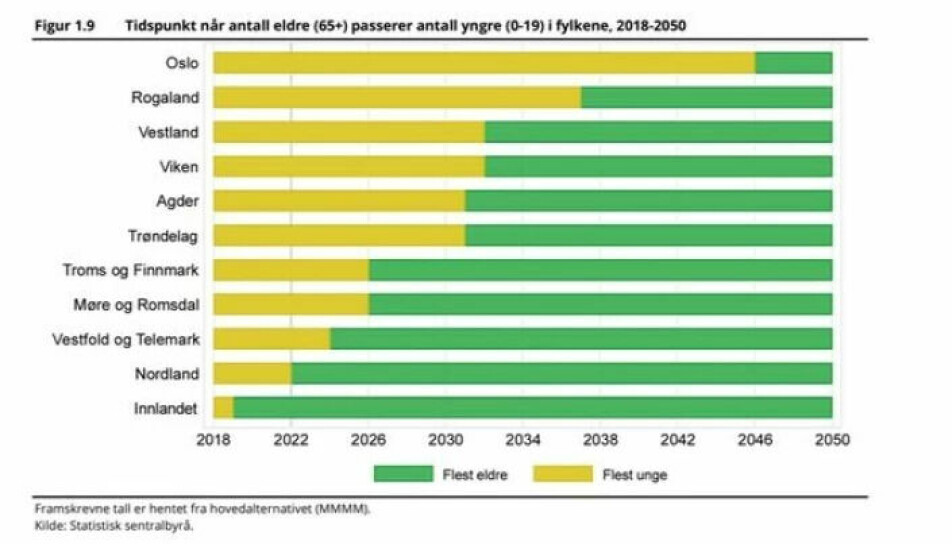
For a long time, women have lived much longer than men in Norway. Now men are catching up
Norwegian men are finally catching up on life expectancy.
In 2021, life expectancy for men was 81.6 years.
In 2060, Statistics Norway expects men to live until they are 89 years old, on average.
This is an extreme difference from 1970, when men lived on average until they were around 70 years old.
Women can also expect to live many more years. But researchers believe they will have a slightly weaker development.
In 2021, a Norwegian woman had an average life expectancy of 84.7 years.
In about 30 years, women can expect to live until they are 91 years old.
Used to be a seven-year difference
There has been an increase in life expectancy in the population every year, according to Statistics Norway.
But around 1950, something happened. The life expectancy between men and women began to differ from each other.
Men's life expectancy remained stagnant and partly declined. For women, the development was better.
In 1970, the difference in life expectancy was around seven years between the sexes.
“Probably due to lifestyle changes”
In recent years, however, men have started to catch up with women.
“It's probably due to lifestyle changes, such as tobacco, alcohol and diet,” Ane M. Tømmerås says.
She is one of three researchers from Statistics Norway who presented the national population projections at a seminar in Oslo on 5 July.
The closing of the gap in life expectancy is however not an unusual development, Tømmerås explains.
“Historically, women have always been slightly above men in life expectancy. The gap we had around the 1970s is more startling than what is happening now, which is that the situation is beginning to normalise,” she says.

Many more become really old
Many more men and women will live to become really old in 2060.
Today, there are around 700,000 people over the age of 70 in Norway. In 2060, researchers believe that this number will approach 1.4 million.
And it is especially the very oldest that are becoming more numerous.
Statistics Norway believes that there will be three times as many 80-plus and four times as many 90-year-olds.
Many more old immigrants
The composition of the oldest in society will be quite different than it is today, the researchers believe.
When people born here in Norway reach the age of 90 in 2060, a much larger proportion of their peers will come from other cultures.
Today, the immigrant population is quite young, compared to those born in Norway. Only 5 per cent are over 70 years old.
In 2060, this share will approach 25 per cent, according to calculations.
“We will have much greater diversity in the older population,” says Tømmerås.
For a long time, Oslo will have the youngest population
Norway as a whole will have an older population, but the changes will not happen in the same way all over the country.
“Many young people move from the districts to more central areas to have and raise their children. Therefore, the population in the districts is becoming older, as there is little replenishment of children and younger people,” Sturla Løkken says.
The pattern is reinforced by the fact that people are living longer and longer due to increased life expectancy.
Already in 2019, Innlandet county, in mid-Norway, had more older than young people.
The same happened in Nordland in Northern Norway in 2022.
Oslo has a young population and is only expected to reach this point in 2046.

More people will die than be born
In less than 30 years, more people will die each year than are born in Norway.
After that time, only immigration will contribute to the population’s growth.
But immigration will be lower in the future, Statistics Norway researchers believe.
They estimate that around 11,000 – 12,000 immigrants will come to Norway each year. This is quite a lot lower than in the mid-2000s.
“Aging does not only happen in Norway. It happens all over the world. Those who come to a country as immigrants are often young. We therefore believe that there are fewer who will leave their own country in the future,” says researcher Stefan Leknes.
Immigration is most uncertain
The researchers emphasise that immigration is the most uncertain factor in their models.
“Will the climate crisis lead to more immigration to Norway in the future? Will there be any new countries in the EU? This and other things can have a bearing on immigration to Norway,” says Leknes.
This year, it has been particularly demanding for researchers to make projections. The war in Ukraine is an uncertain factor.
They base their models on the fact that Ukrainian refugees will still come to Norway next year, in 2023.
———
Translated by Alette Bjordal Gjellesvik.
Read the Norwegian version of this article on forskning.no
Sources:
Ane M. Tømmerås and Michael J. Thomas Norway’s 2022 national population projections, Statistics Norway, July 2022.
Stefan Leknes and Sturla A. Løkken Municipal population projections 2022, Statistics Norway, July 2022.

































